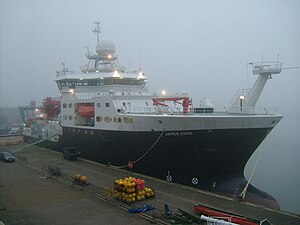RRS James Cook
 RRS James Cook in dock at the National Oceanography Centre, Southampton
| |
| History | |
|---|---|
| Name | RRS James Cook |
| Namesake | James Cook |
| Owner | NERC Research Ship Unit |
| Builder | Flekkefjord Slipp & Maskinfabrikk AS, Norway. Hull built in Gdansk, Poland |
| Cost | £36 million |
| Laid down | January 2005 |
| Christened | February 2007 by HRH Princess Royal |
| Maiden voyage | 5 March 2007 |
| Identification |
|
| Status | in service |
| Notes | [1][2][3] |
| General characteristics | |
| Class and type | Lloyds +100A1, Ice 1C, FS, +LMC, UMS DP(AM) Research Vessel |
| Displacement | ~5800 tonnes |
| Length | 89.5 m |
| Beam | 18.6 m |
| Draught | 5.5 – 5.7 m |
| Installed power |
|
| Propulsion |
|
| Speed | 16 knots |
| Crew | 9 Officers; 13 Crew & Technicians; 32 Scientists |
| Notes |
|
The RRS James Cook is a British Royal Research Ship operated by the Natural Environment Research Council (NERC). She was built in 2006 to replace the ageing RRS Charles Darwin with funds from Britain's NERC and the DTI's Large Scientific Facilities Fund. She was named after Captain James Cook, the British explorer, navigator and cartographer at the National Oceanography Centre, Southampton by HRH The Princess Royal.[5]
On her maiden scientific voyage, on 5 March 2007, James Cook was involved in the discovery of what is believed to be the world's deepest undersea volcanic vents, while in the Caribbean.[6]
In September 2015, while on a cruise studying the seabed and marine life of the Whittard Canyon on the northern margin of the Bay of Biscay, oceanographers believe they pictured the first blue whale in English waters since the mammals were almost hunted to extinction in the north-east Atlantic.[7]
-
James Cook in Valparaiso
-
James Cook returns to Southampton following a two week cruise testing new ROVs
References
- ^ "Planet Earth" (pdf). NERC. Spring 2007. Retrieved 4 January 2008.
- ^ "RRS James Cook". NERC. Archived from the original on 3 July 2012. Retrieved 4 January 2008.
{{cite web}}: Unknown parameter|dead-url=ignored (|url-status=suggested) (help) - ^ "RRS James Cook". National Oceanography Centre. Archived from the original on 10 June 2008. Retrieved 4 January 2008.
{{cite web}}: Unknown parameter|deadurl=ignored (|url-status=suggested) (help) - ^ "RRS James Cook Ship Specification". rrsjamescook.com. Retrieved 9 October 2010.[permanent dead link]
- ^ "RRS James Cook named by HRH The Princess Royal". Natural Environment Research Council. Retrieved 12 April 2010.
- ^ "British scientific expedition discovers world's deepest known undersea volcanic vents". physorg.com. Retrieved 12 April 2010.
- ^ Morris, Steven. "Blue whale caught on camera in English waters 'for the first time'". theguardian.com. Retrieved 7 September 2015.
External links
- National Oceanography Centre - Sea Systems - RRS James Cook, Southampton
- Movie of the hull launch of the RRS James Cook in Gdansk, Poland


